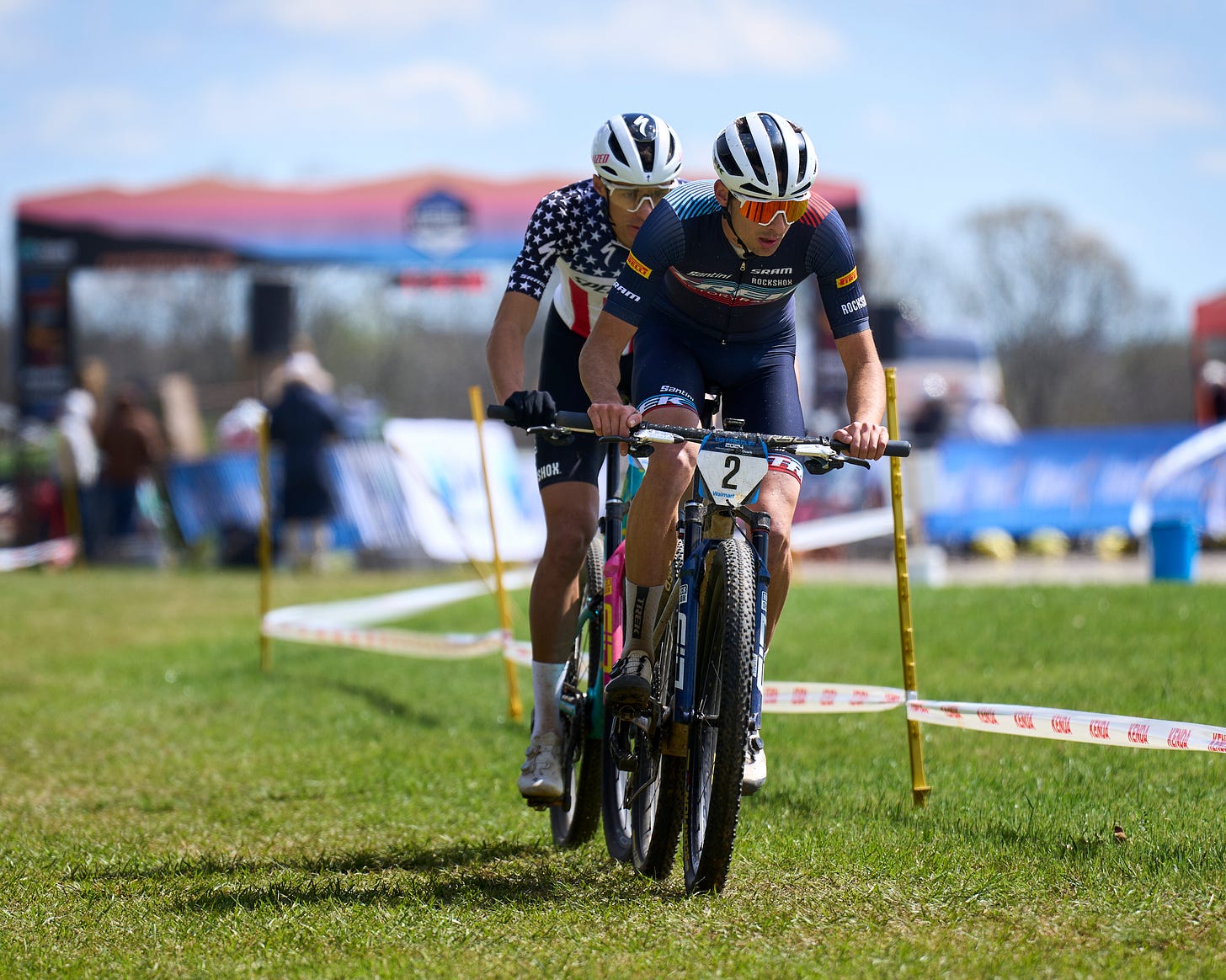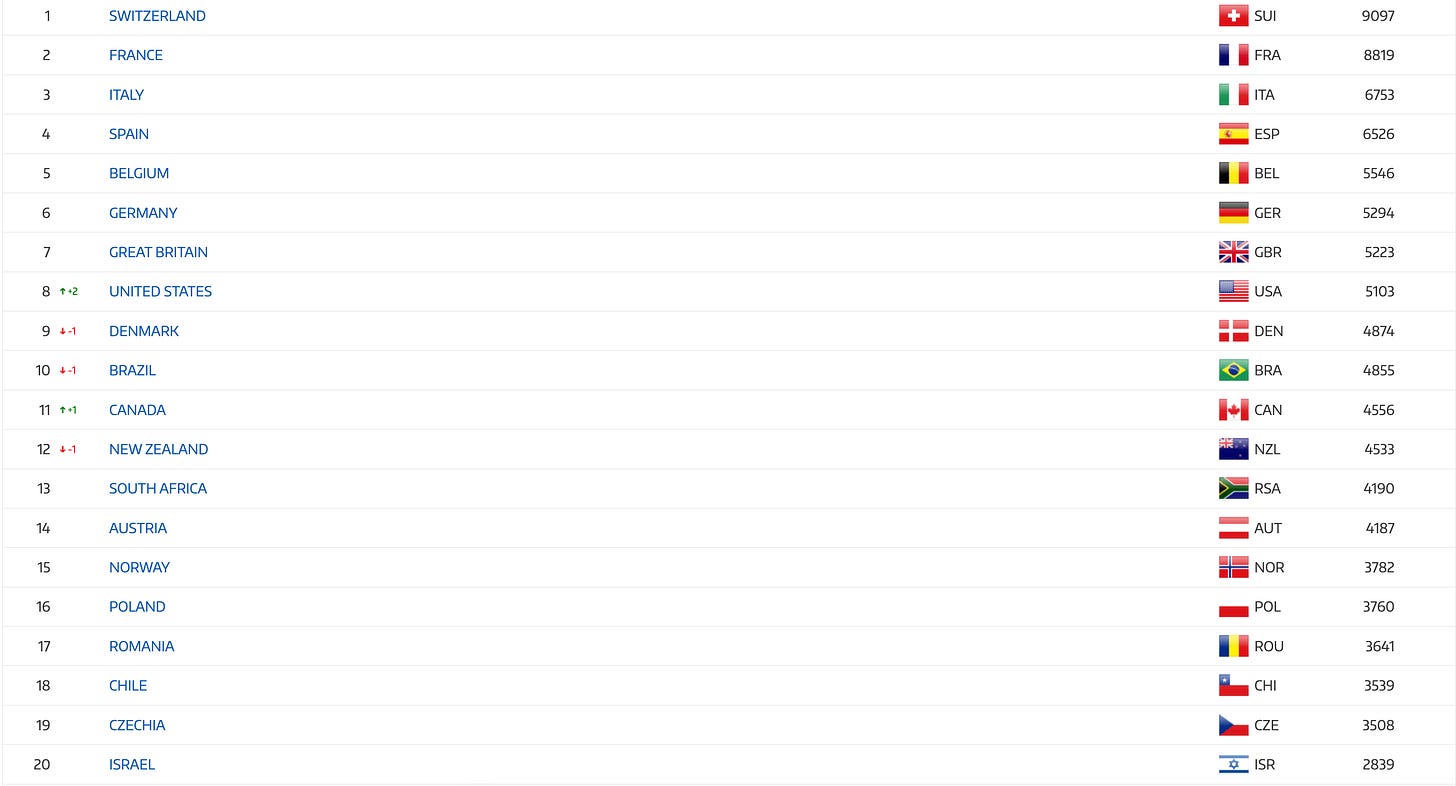Making Sense Of The Olympics MTB Selection Process
Team USA hunting points to secure four starting spots in Paris

At a CXD Trek Bikes team dinner the other night in Fayetteville, Arkansas, a group of athletes, friends and family got into a lengthy discussion about rider selection for the mountain bike cross-country race at the upcoming Paris Summer Olympics. Although this conversation went on for a while and really got into the weeds concerning the selection process, I wasn’t confident that we got it exactly right at the end of the night. So, being a bit of a selection criteria nerd, I figured I should do some actual research into how you get to the start line in Paris.
To begin, the selection pool is small. So small that the combined men’s and women’s fields could travel together on a single bus to the venue.
Contrast that one-bus commute to last year’s MTB XCO World Cup round at Nove Mesto Na Morave, where 132 elite men and 96 elite women toed the line. Not to mention, 143 U23 men and 82 U23 women also raced. That’s 228 elite riders (and 225 U23 riders) competing at one World Cup event. Compare that to the Olympics, where 72 athletes will compete in the MTB cross-country race, and you can see why Olympic years are crazy for mountain bikers.
The Olympics are the ultimate goal for MTB athletes. There’s no Tour de France or Paris Roubaix. The Olympics is the pinnacle, and only a fraction of the average field size is allowed to compete: thirty-six men and thirty-six women. That’s it.
So, how do you get to be in that number? Like most bike racing selection criteria, it’s not straightforward. To see how convoluted it can get, all you need to do is look back at how Great Britain’s Tom Pidcock needed Romanian Vlad Dasaclu to finish 17th at Nove Mesto, so Frazer Clacherty’s 14th place at the U23 world championships earned Great Britain a spot, and Pidcock was able to race. I explain Pidcock’s path to the Olympics in more detail in this post.
With the preamble out of the way, let’s try to break down this selection process.
As the host nation, France automatically gets one spot in the men’s and women’s races1, while two more will be set aside for Universality Places2, which will be decided by the Tripartite Commission. That leaves 68 spots for the rest of the world to fight over.
In Tokyo, it was possible for top National Olympic Committees (I’m using NOC or Nation interchangeably going forward) to qualify three riders in the men’s and women’s races. For Paris, the maximum a nation can qualify is two riders for the women’s race and two riders for the men’s race. A change that opens up slots for more Nations farther down the rankings.
Points earned in Olympic qualification events from May 7, 2022, to May 26, 2024, count towards NOC start spots. UCI rankings will be decided by adding the points of the three highest-ranked athletes from each nation across the qualification period.
Nations ranked one to eight on May 26 will qualify two athletes. Nations ranked nine to 19 will qualify one athlete.
Nations ranked 20th and below will not be automatically eligible to send athletes to the Olympics. For these Nations, athletes will qualify for the final seven spots on the men’s and women’s starting grid by being the highest-ranked finisher at a continental or world championship during the qualification period. This part of the selection process played a role in the wild Pidcock saga mentioned above.
Here are the specifics, according to Olympics.com, on how those Nations ranked 20 and lower can send an athlete to the Olympics:
· A maximum of two Continental Championships are included in the rankings, with the last two to take place counting if there are more than two.
· Outside of Europe and Oceania, a maximum of one athlete can qualify per NOC at the Cross-country Continental Championships for Africa, America and Asia—with the highest-ranked NOC allocated each place.
· The two highest-ranked NOCs at the 2023 UCI Mountain Bike World Championships in both the elite and under 23 races, which have not qualified a quota place through the UCI Mountain Bike Olympic Qualification ranking or the 2023 Continental Championships, will qualify a maximum of one place per NOC, with NOCs which have qualified through the elite race not eligible to qualify through the under 23 race.
In other words, if you finish 15th at the World Championships and everyone who finished above you races for an NOC that is in the top 19, congratulations, you’re Nation is racing at the Olympics.
The current Nations rankings for the men are here and for the women are here.
What This Means for Team USA
For the U.S., the men are currently ranked tenth with 4818 points. Denmark is currently in the eighth spot with 4874 points. Christopher Blevins, Riley Amos and Bjorn Riley are the three top U.S. riders that determine Olympic Nation ranking.
The rankings on the UCI website were last updated April 1 and do not include this past weekend’s races in Fayetteville where Amos earned 200 points. Forty for the second-place finish in the C1 on Wednesday, 60 for the U23 HC win on Friday and 100 for the HC elite win on Saturday. Blevins earned 60 for the C1 win on Wednesday and 35 for his sixth-place finish in Saturday’s HC.
As I mentioned in my recap of the US Pro Cup racing, the men’s U23 HC XCO event was initially scheduled for Saturday with the rest of the HC XCO events but was moved to Friday at the request of USA Cycling. The main reason for this specific schedule change is to allow athletes to gain as many points as possible in an Olympic year. Allowing Riley Amos to have an opportunity to race the U23 and the elite race by putting them on separate days makes it possible for him and others to double up on valuable UCI points. For Team USA, this schedule change paid off.
Without considering what other Nation riders may have done over the weekend, the 295 points Amos and Blevins earned provisionally move the U.S. into eighth place behind Great Britain. The goal is to stay there through the end of May and secure the two slots in the starting grid. [Update: the rankings were updated this morning and the U.S. is now in eighth place, 120 points ahead of Denmark. Here’s the top 20 as it stands on April 8.]
For the women, the U.S. is ranked fourth with a safe buffer zone of close to 3000 points between their current position and falling out of the top eight. The U.S. women, who are secure in their nation ranking, can now focus on themselves to see who, amongst Kate Courtney, Gwen Gibson, Haley Batten, and Savilia Blunk, will earn the two Olympic spots.
France is in the top eight for men and women so they will more than likely have two racers in each field but one is guaranteed.
Note on Universality Places from the IOC: “The objective of the Commission is to manage the allocation procedure for Universality Places offering the opportunity to NOCs, which have traditionally sent small delegations to the Olympic Games, to be represented at the next edition of the Games. A further objective of the Commission is to contribute to enhancing and reflecting universality by selecting athletes from such NOCs, which have not been able to qualify, so that they may have an opportunity to be invited to compete in sports and disciplines for which Universality Places have been reserved.”







My only comments are that invariably some great riders won’t be at the Olympics.. the US women being a case in point, that the fields are ridiculously small when you think of just the field for the 100 metres ..let alone all track and field..and ‘shooting’ etc, that MVDP could win gold ( maybe this is the year he actually prepares properly IDK) which as a huge MVDP fan I would love but part timers like Matthieu and Pidders are cheating to some extent riders who give everything to make XCO a spectacle every season by contributing - in reality, very little. I guess I’d say that you had to do a minimum of World Cup races- 6- maybe 8 in each of the 2 seasons prior to the Olympics .
It’ll be a fun watch to see which American women make it. Hopefully no sticks in spokes moments.